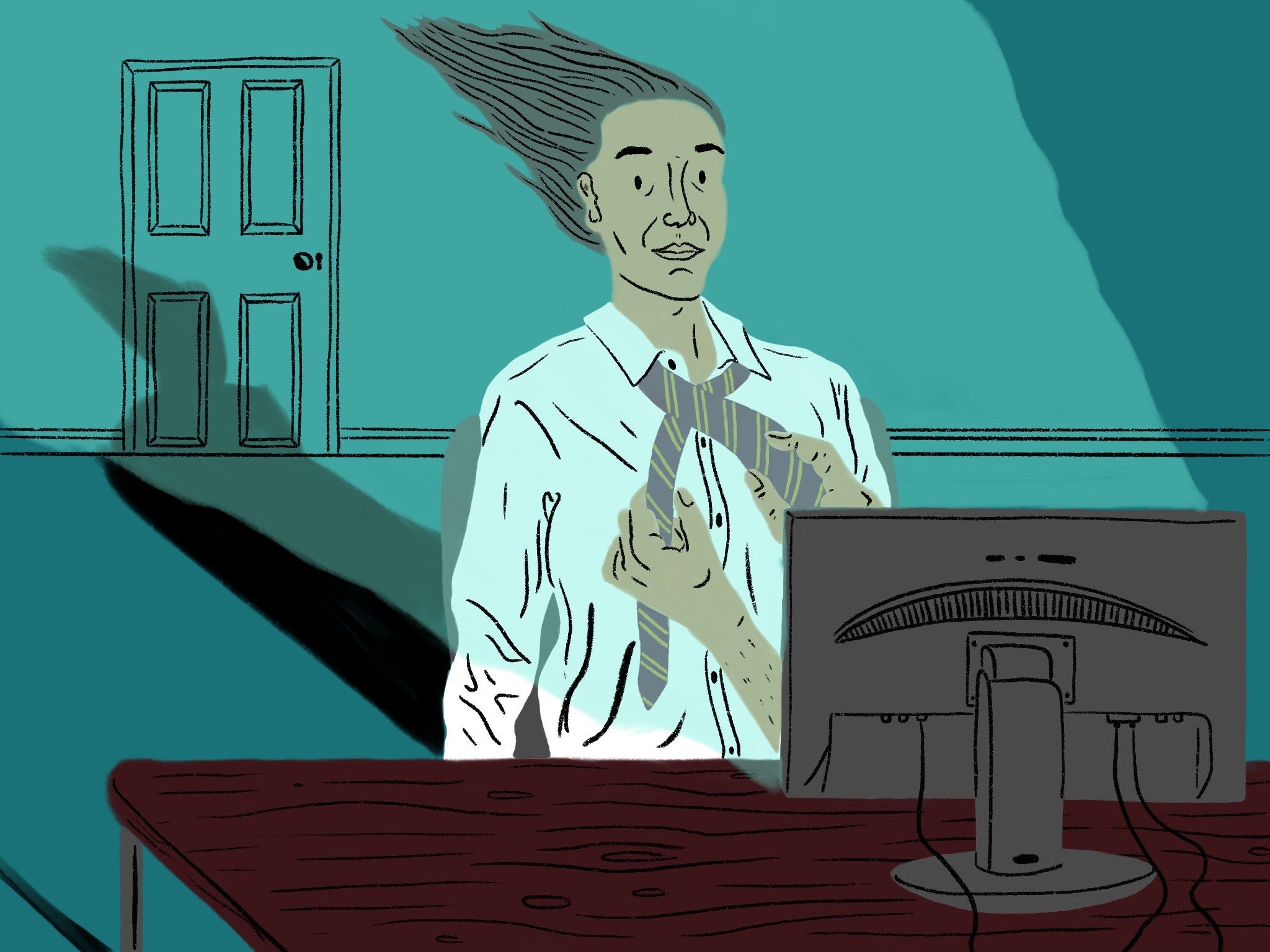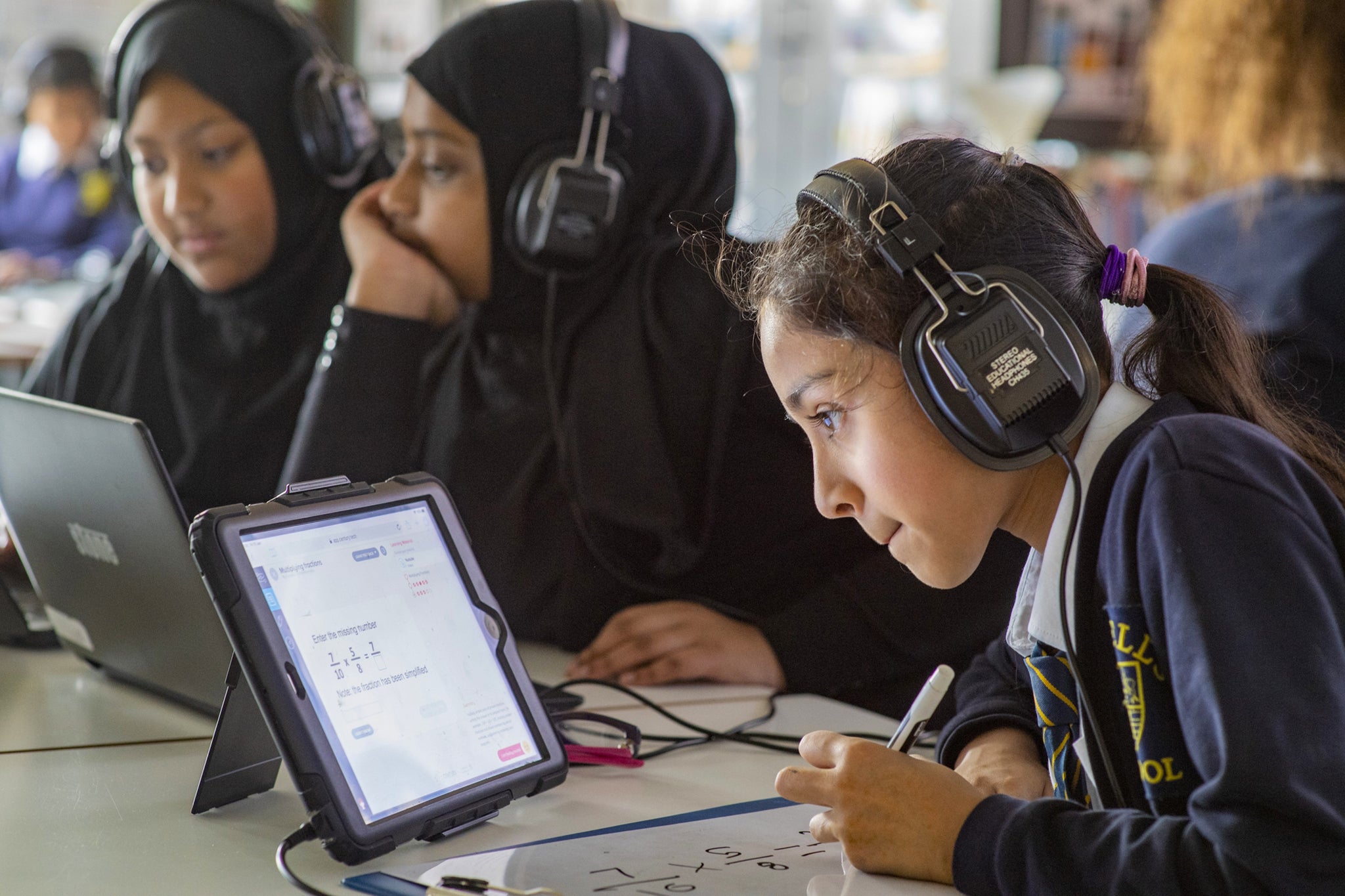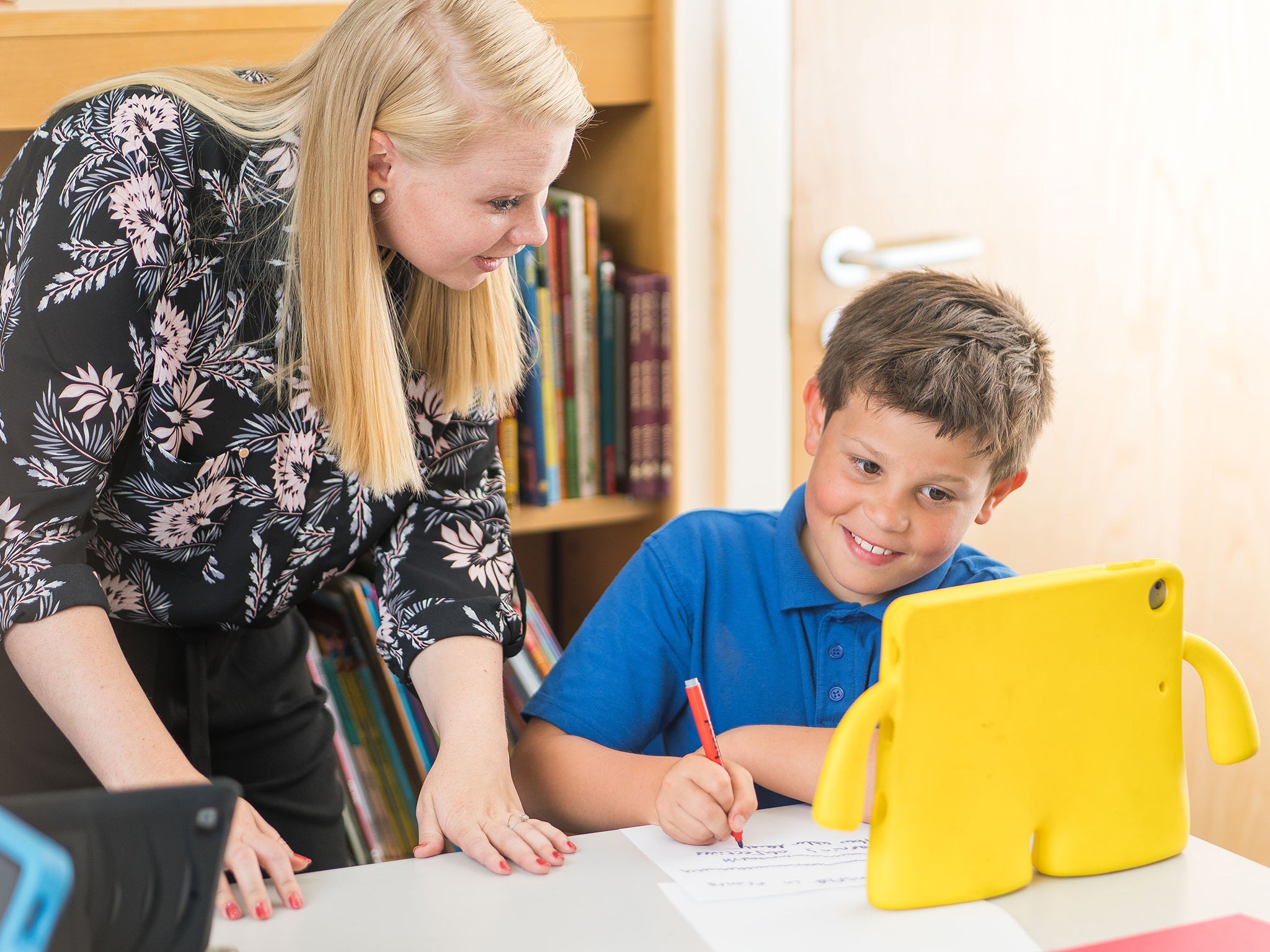AI in our schools – a dystopian nightmare or a bright future?
New technologies in the classroom are giving students a more personalised path to learning. Initial results are promising but, Sonia Klug asks, what are the risks and benefits of letting machines teach the next generation?


In 2018, then education secretary Damian Hinds challenged the tech industry to launch an education revolution for schools to reduce the burden on teachers. There is now a myriad of online resources used in UK schools. Particularly notable are some AI-powered platforms, which have been shown to improve exam results, but few studies on how they affect children in the long-term have been done. Are we holding our children back by our hesitation to adapt to these platforms, or are we putting them at risk by exposing them to powerful technologies without rigorous testing?
The Keys Federation Academy Trust has been rolling out Century Tech, an AI-powered teaching and learning platform, across their four primary schools. Every pupil starts using this online resource from age seven. Teachers use the system to assess students’ abilities, pinpoint misconceptions and gaps in their knowledge, and identify their individual learning style. The Century software uses deep learning – a type of AI where machines learn by experience and acquire skills with minimal human involvement – to get to know each pupil so it can tailor content, including micro-lessons, called “nuggets”, to each student’s needs.
It’s too early to compare end-of-year results but the initial findings are very promising. Sharon Bruton, CEO of the trust, says schools have seen a 30 per cent increase in performance and students became faster at answering questions after using the platform, speeding up from 4.35 to 0.94 seconds. Additionally, the data shows that the more time the pupils spend on the platform, the higher their attainments. The system also helps to stretch higher achievers, as well as keeping absentees up to date.
In one academic year, more than a quarter of a million questions have been answered and automatically marked, saving teachers an average of six hours of work per week. Bruton says it gives the teachers far greater flexibility and helps children adapt to a world where they will need to learn through a variety of different formats.
Sally Naylor is a Year 6 class teacher at the trust and her pupils usually spend between 30 and 40 minutes (60 minutes maximum) per day on the Century platform.
“There has been a huge increase in engagement from the pupils”, she says. “I sometimes use it at the start of a session to give them a short blast [of the topic] or at the end of the lesson to see how much they have learnt and to consolidate their learning. I also give them two nuggets as homework a week. It’s been instrumental in getting the Year 6s ready for their SATs last year.
“It’s tailored to each child, and that really helps in the classroom. The children enjoy going on Century Tech, and it means we have more time for creativity in lessons. It’s an absolutely fantastic tool and reduces the workload for the teacher.”
Charlie Harrison is one of her pupils and particularly likes the maths micro-lessons. He says: “I like how I improve when I do the nuggets. It seems much easier afterwards, and I can do it with more confidence. It helps me to learn faster.” Fiona Harrison, Charlie’s mother, feels it gives her a much better insight into his progress and what he learns. She says “it’s like having a teaching assistant at home”.
Scott Hayden is the digital innovation specialist for the Basingstoke College of Technology. He chose Century for the college because of its approach to teaching and learning and space for collaboration. It’s used across the college, led by the teachers and only for a limited amount of time. Like Burton, he sees the value in an AI system that can ”free” teachers. Hayden says: “It’s a great diagnostic tool and allows us to have more one-on-ones, to mentor, coach and empathise. It gives our staff more time to develop human skills, which can never be automated.”

Kevin Stannard, director of innovation and learning at the Girls’ Day School Trust, is also currently looking into integrating AI, but has a more cautious approach. “There is great potential for AI to break the log jam that exists around assessments, move towards adaptive testing, streamline admin and cater to different kinds of students,” he says.
“If done right, it could be fantastically liberating and also help with what is often termed ‘slow learning’ or learning that is paced to the needs of individual learners and gives room for depth and reflection. But it’s important to look at who is doing the development. Education should not be driven by commercial requirements.”
He adds: “There is also the danger of deskilling the educational profession and other potential unintended consequences that are difficult to foresee.”
Tech has changed the world as we know it – from the labour market to how we produce, consume and process the exploding amount of information available to us. With more and more work being automated, it’s the human or, as they are often labelled, “soft” skills, such as empathy and creativity, that will become more important.
It gives our staff more time to develop human skills, which can never be automated
According to the global consultancy McKinsey & Company, today’s children will need to excel at social and emotional, technological, and higher cognitive skills to maximise their chances of getting work in the future. Yet schools operate very much like they have done for hundreds of years – one teacher in front of 30 pupils, imparting and testing knowledge. There is a debate about how education has to change to prepare our children for the world of tomorrow.
Rose Luckin, a professor at UCL, believes that not enough is being done to tackle current educational challenges. As a director of EDUCATE, the university’s ed-tech research programme, she works with startups (including Century Tech), educators and academics to develop digital systems that are effective in teaching children, while still meeting ethical standards.
“We need to side-step the rather unhelpful debate between knowledge and skills and think about it in terms of intelligence and learning,” she says. ”The real potential of AI is when we stop thinking of it as individual technologies. The real power lies in an intelligence infrastructure, combining masses of data, smart algorithms, processing power and memory, analysing students’ actions and interactions with teachers, and when learning outside the classroom.
“This could help teachers and students better understand how students learn, including their emotional and social intelligence. It’s very holistic. If we get it right, an AI intelligence infrastructure will power all learning interactions with any technology or just with other people. It could also help us to develop a rich understanding of ourselves as an individual, as well as how to pull together with others and interact effectively, make good judgements and make sense out of our physical presence and experience of being in this world.”
The stakes are high and the potential so vast that a recent report by global intelligence platform HolonIQ predicts an explosion of innovation and investment in education, reaching $341bn (£275bn), by 2025, with China, the US and India taking the lead.
China is leading the way with AI development. In 2017, it announced their “Next Generation AI” strategy, which includes 1 trillion yuan (£113bn) investment, with a focus on AI-based STEM teaching to develop the next cohort of AI talent. Singapore is also heavily investing in AI in education and Flanders in Belgium has just signed a contract with Century Tech to integrate their learning platform into all 700 state-funded schools.
The UK is lagging far behind. In a recent report on the subject, the innovation foundation Nesta could identify only £112m of private investment since 2006 and only £1m of public investment between 2014 and 2017.

The fact that AI for schools is largely driven by private companies causes some unease. Carl Honoré, author of Under Pressure: Putting the Child Back In Childhood and often referred to as the voice of the global Slow Movement, says: “There is clearly a lot of potential for this technology in education and, done right, it could be a beautiful thing, but we need to do our due diligence first.
“With the first wave of technology for schools, there were some quite bold corporate messages piggybacking onto it and into the classroom. An online platform is less transparent than a printed curriculum, and that makes it much easier to smuggle in ideological messaging.
“There is also the danger that it will be tainted by the prejudices of its makers, which have been shown to be reproduced in AI. The classroom should be a safe space, and the grubby hands of commerce and ideology should be kept at bay as much as possible. Education should be a public good, run by and for the public.”
The classroom should be a safe space, and the grubby hands of commerce and ideology should be kept at bay as much as possible
His worries were reflected in a YouGov survey, commissioned by Nesta, which found that 78 per cent of parents would be worried about determinism (that an AI system would exercise an undue influence on their children’s opinions and/or life choices), 73 per cent about data and security and privacy, 77 per cent about transparency and another 77 per cent about accountability.
Every expert and educator interviewed affirmed that software must never replace teachers and recognised the important work teachers did. They all considered them vital, not only to our children’s learning but also teaching them the soft skills they’ll need to thrive in their personal as well as working lives. In fact, for Priya Lakhani, founder and CEO of Century Tech, helping teachers was one of the biggest drivers behind the development of the platform. “I see Century as a ‘sidekick to the superhero, the teacher’. I wanted to supercharge them to do what they do best, which is interacting with the pupils, teaching the soft skills and furthering their creativity.”

While there is no evidence for it, there is a risk that such a platform could be overused, especially in less than ideal circumstances. For example, a school that is under pressure to improve results or inexperienced teachers without the support they need may become over-reliant on the system at the cost of human interaction.
Recent budget cuts have already forced schools to reduce their teaching staff. Could digital platforms accelerate this trend? Although Luckin is generally optimistic, she admits to sometimes seeing it as a dystopia nightmare, where only wealthy children are taught by actual teachers, and everybody else is plugged into screens, supervised by childminders.
A truly intelligent AI would need to understand how engaging with this technology affects children’s development, including when they’re offline. The kind of intelligent infrastructure Luckin refers to would do this, but it’s still some way off. In the meantime, we’re only just beginning to understand how the use of digital technologies affects our brains.
If the learning for students is always frictionless, we’re setting them up for failure because the real world is full of friction
For example, will optimally engaging pupils by calibrating the material they see, so that it is neither too easy nor too difficult, make everything else more tedious by comparison? We know that computer games aim to hit that sweet spot between effort and reward hijack our dopamine circuits. Will spending an increasing amount of time on such platforms lower our children’s tolerance for boredom and frustration in general?
“AI promises a seamless, pain-free world without struggle or delay. But if the learning for students is always frictionless, we’re setting them up for failure because the real world is full of friction,” says Honoré. ”Whether it’s human relationships or reading a profound book, so many things in life require us to push through some boredom or awkwardness or uncertainty before reaping the rewards.”
A now frequently cited study shows that the presence of a camera in the classroom causes children’s learning to shift from being intrinsically to extrinsically motivated, meaning that rather than learning because they enjoy it, they learn because they are watched and/or praised. Being monitored by an AI system could have the same effect and negatively affect children at a young age, when they start to develop their sense of self.
Interestingly, many of the people who have shaped our virtual world from Silicon Valley limit their children’s screen time and send them to Steiner schools, where screens are only slowly introduced from age 10 or 11.
Frances Russell, executive director of the Steiner Waldorf Schools Fellowship, says that Steiner schools place as much importance on social and emotional development as academic achievement. “For us, a strong relationship between the pupil and the teacher is of central importance,” she says. ”In the early years, particularly, we believe that children learn most through hands-on experiences in the real world and only when they have an autonomous relationship with that world, do we introduce the virtual world. In this way, children are more likely to be in control of the technology than be controlled by it.”
There are also leaders of mainstream schools who remain critical. Doug Lemov, author of Teach Like a Champion and managing director of Uncommon Schools, which runs 54 state-funded schools in the US, says: “We often rush to bring technology into schools because we see the potential benefits but are less attentive to the costs. A great deal of data is emerging to suggest that technology changes the ways we think – it fractures our concentration and, in offering constant distraction, literally rewires our brains.
“Schools are one of the last places where we can limit the presence of technology, making it one of the few places where we can cause people to sustain concentration or to listen carefully to one another without distraction. The question isn’t whether technology can add value in schools, but whether it adds more than it takes away and whether it is more valuable than those humble, but deeply profound alternatives, many of which serve as checks upon the way technology is changing our cognitive patterns. And unfortunately once a technology has come in the door and become a part of an environment it’s hard to get it back out.”
Luckin says there is an urgent need for more research, broader debate and the development of an ethical framework for technology in classrooms, as well as how education needs to change to shape the future.
Does she think we’re asleep at the wheel? “At the wheel? We’re not even in the car! We haven’t even got up yet. We’re still in bed, asleep with earplugs in and an eye mask on. We need to wake up!”
Join our commenting forum
Join thought-provoking conversations, follow other Independent readers and see their replies
Comments